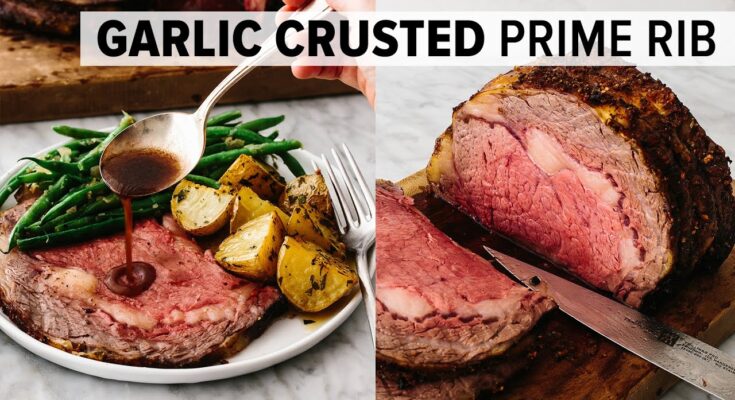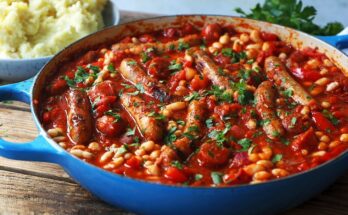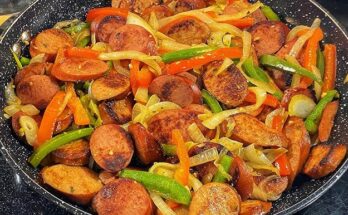Prime Rib Recipe: Cooking prime rib might sound intimidating, but once you master it, you’ll see it’s a game-changer for any holiday or special dinner. With its juicy interior and flavorful crust, prime rib is a crowd-pleaser. Whether you’re making it for Christmas dinner or a weekend feast, this guide will take you step-by-step through the process to ensure it’s cooked perfectly every time. Ready to impress your guests? Let’s dive in!
What is Prime Rib?
Prime rib, also known as a standing rib roast, is a cut of beef from the rib section. It’s prized for its marbling, tenderness, and rich flavor. The “standing” part comes from the fact that it’s often roasted with the ribs standing upright.
This cut can be bought bone-in or boneless. Bone-in prime rib tends to retain more flavor, while the boneless version is easier to carve. And although the name might confuse people, prime rib isn’t always USDA Prime grade; many restaurants and home cooks use USDA Choice, which still delivers excellent results.
Choosing the Right Cut
When buying prime rib, consider how many guests you’ll be serving. A good rule of thumb is to buy one rib per two people. For smaller gatherings, a three-rib roast will serve about 6-8 people.
You’ll also want to pay attention to the meat grade. USDA Prime has more marbling and flavor, while USDA Choice is more affordable and still delicious. Whichever you choose, ask your butcher for a well-marbled piece—it makes all the difference.
Ingredients Needed for Prime Rib
Here’s what you’ll need to create a flavorful roast:
- 1 (5-7 lb) bone-in prime rib roast
- Salt and freshly ground black pepper
- 3-4 garlic cloves, minced
- 2 tbsp fresh rosemary, chopped
- 2 tbsp olive oil
- Optional: Red wine for an au jus sauce
Equipment Required
- Roasting pan with rack
- Meat thermometer (essential!)
- Aluminum foil
- Chef’s knife for carving
- Oven-safe skillet (if searing)
Preparing the Prime Rib: Step-by-Step
Step 1 – Bring the Meat to Room Temperature
Remove your prime rib from the fridge about 2 hours before cooking. This step ensures that the roast cooks evenly and doesn’t end up raw in the center.
Step 2 – Seasoning the Meat Properly
Generously season the roast with salt and black pepper. You can also rub it with garlic and rosemary for extra flavor. Don’t be afraid to go heavy on the seasoning—this cut of meat can handle it.
Step 3 – Letting the Seasoning Rest
After seasoning, let the prime rib sit for 30 minutes to an hour. This resting time allows the flavors to penetrate the meat.
How to Roast Prime Rib Perfectly
Step 1 – Preheating the Oven
Preheat your oven to 500°F (260°C) for a quick initial sear. Lower the heat after searing to 325°F (163°C) for the remainder of the cooking process.
Step 2 – Searing the Prime Rib (Optional)
For an extra-crispy crust, you can sear the prime rib in a hot skillet before roasting. Simply heat some oil and brown the roast on all sides.
Step 3 – Roasting the Meat Slowly
Place the prime rib in a roasting pan, rib-side down. Roast it at 325°F until your meat thermometer reads:
- Rare: 120°F (49°C)
- Medium-rare: 130°F (54°C)
- Medium: 140°F (60°C)
Plan on about 15-20 minutes per pound, but always rely on your thermometer for precision.
How to Use a Meat Thermometer
Insert the thermometer into the thickest part of the roast, avoiding the bone. Monitor the temperature closely—prime rib continues to cook as it rests, so pull it out 5-10°F below your target temperature.
Resting the Meat After Roasting
Once out of the oven, cover the roast loosely with foil and let it rest for 20-30 minutes. This step is essential for juicy, tender meat, as it allows the juices to redistribute.
Carving the Prime Rib
Use a sharp chef’s knife to slice between the bones if bone-in, or make thin slices for serving. Cutting against the grain ensures tender bites.
Serving Suggestions
Prime rib pairs wonderfully with sides like garlic mashed potatoes, roasted Brussels sprouts, and Yorkshire pudding. For sauces, try a classic au jus or a tangy horseradish cream.
Prime Rib Cooking Variations
- Reverse Sear: Cook the meat slowly at low heat, then finish with a high-temperature sear.
- Smoked Prime Rib: Add smoky flavors by cooking it in a smoker for 3-4 hours.
- Garlic Butter Crust: Top the roast with garlic butter during the last 10 minutes for extra richness.
Tips for Leftover Prime Rib
Refrigerate leftovers promptly in an airtight container. Use them to make prime rib sandwiches, tacos, or breakfast hash the next day!
Common Mistakes to Avoid
- Overcooking: Use a thermometer to avoid this!
- Skipping Rest Time: Letting it rest ensures juicy meat.
- Cutting Too Soon: Don’t carve right away—patience is key.
FAQs about Prime Rib Recipe
1. What is the best cut for prime rib?
The best cut for prime rib is the first five ribs from the loin end, often called the “first cut” or “small end.” This section is more tender and flavorful, making it ideal for roasting.
2. How long should I cook a prime rib?
The cooking time depends on the size of the roast and the desired doneness. For medium-rare, roast at 325°F (163°C) for about 15 minutes per pound, followed by resting for 15-20 minutes before carving.
3. Should I season the prime rib in advance?
Yes, seasoning the roast with salt and herbs at least 24 hours in advance allows the flavors to penetrate deeper, enhancing the taste and creating a perfect crust.
4. Do I need to let the prime rib rest before serving?
Absolutely! Resting the prime rib for 15-20 minutes after roasting helps redistribute the juices, ensuring a juicy and tender cut with every slice.
5. What sides pair well with prime rib?
Popular side dishes include garlic mashed potatoes, roasted vegetables, Yorkshire pudding, and creamed spinach, all complementing the rich flavors of prime rib.
6. Can I make prime rib in advance?
While it’s best served fresh, you can roast it ahead of time and reheat slowly in the oven at low heat to maintain the juiciness without overcooking.
7. How do I store leftover prime rib?
Wrap leftovers tightly in foil or place them in an airtight container. Refrigerate for up to 4 days or freeze for up to 3 months for later use.
Conclusion
Making the perfect prime rib is all about mastering a few key steps: selecting a well-marbled cut, seasoning generously, and slow-roasting to achieve a tender and juicy result. Remember to let it rest before slicing for maximum flavor.
Whether it’s for a holiday feast or a cozy family dinner, prime rib is sure to impress. Give it a try at your next celebration and enjoy the compliments that come with serving such a savory and delicious dish!
References
Citing reputable sources ensures accuracy and enhances trust in the information provided. For further reading and in-depth exploration of prime rib recipes, check out the following references:
- AllRecipes: Prime Rib Recipe – A detailed guide with tips on seasoning and cooking methods for achieving the perfect prime rib.
- Food Network: Prime Rib Roast Tips – Expert advice from chefs, including variations and serving ideas.
- Bon Appétit: Prime Rib Cooking Techniques – An insightful resource for mastering slow-roasting techniques.
- The Spruce Eats: Prime Rib Recipe & FAQs – Offers step-by-step instructions and troubleshooting tips for common cooking challenges.
These sources provide expert advice, alternative methods, and additional insights to ensure a delicious prime rib experience.



